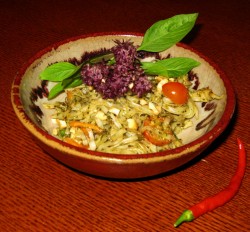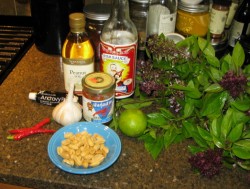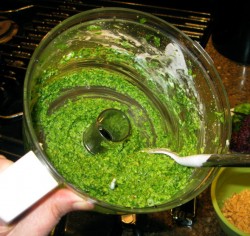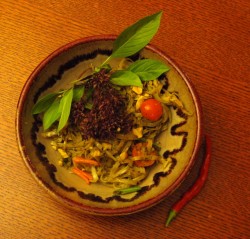Fusion Fun: Thai Pesto Noodles
I am not always one for fusion dishes. Quite a few of them come across as less fusion and more like confusion, with muddled flavors and odd combinations of unrelated ingredients.
t
But, as I was planting my Thai basil this spring, right next to a planter full of Italian and Greek basil, I thought, “I wonder what it would taste like if I took the idea of pesto and made it Thai? I couldn’t imagine it would be bad, and besides, pesto is similar in some respects to Thai curry pastes (and it is very similar to green cilantro chutney in Indian cuisine, but that is beside the point), so there is enough similarity going on that I thought it must be doable.
So, I got to thinking of the ingredients that are in traditional Genovese pesto: basil, garlic, toasted pine nuts, olive oil, Parmesan cheese and salt and pepper.
And I thought, what are the cognates in Thai cuisine? Well, basil is simple–I’d just use Thai sweet basil instead of the Italian type. Garlic is garlic, all around the world, and it is always good. Instead of pine nuts, I could use peanuts. And I could replace olive oil, with fragrant cold pressed peanut oil. But what about the Parmesan cheese?
I was stuck there for a few minutes until I came at the problem from a different direction. Instead of worrying that there is no traditional cheese in Thailand, I thought about what function the Parmesan cheese serves in pesto. I pondered on the issue for a time and realized that while it adds some salt that isn’t the main function of the Parmesan. It isn’t in there to taste “cheesy” either–good pesto doesn’t ever have an overwhelming cheese flavor.
It is there to give the sauce that fifth taste–the jolt of umami–that savory “je-ne-sais-quoi” that you may not be able to identify in a dish, but if it is missing, you notice its lack.
Aha! I had it–what in Thai food is used to give the umami burst? Fish sauce is the most obvious answer, but I didn’t want to use it because I didn’t want to add more liquid to the sauce. Shrimp paste, which is used in many Thai curries is the obvious answer, and were I not possibly allergic to shrimp, that is what I would have used. (And that is what I suggest those who experiment with this recipe use, if they can get it and if they can eat shellfish with impunity, unlike myself. Lucky devils!)
What I ended up using was anchovy paste. Which, while it is an Italian ingredient, makes sense in a Thai context because fish sauce is made from anchovies. Voila!
My basic ingredients were set, but I decided to add some fresh Thai chilies, because I thought the sauce would taste better with them, and because I have been known to add chile flakes to my regular old Italian pesto. And, I decided to add a squeeze of lime juice at the end, after the noodles were tossed, to give a little sparkling finish to the flavors, as is done in many Thai recipes.
And, as I was grinding up the pesto itself in the food processor, I tasted it when it was about halfway there, and realized something about the physical properties of Thai basil vs. Italian basil. Firstly, the leaves are a bit drier in texture, so they don’t emulsify and puree quite so readily and secondly, they are a little bit stringier in texture as well.
I decided that the sauce would need something to help smooth it out and make it creamier. I could have added some water to the mix, in order to make up for the lack of water in the basil’s leaves, but I was afraid it would water down the flavor too much. Instead, I added about three good heaping tablespoons of nice, well-stirred coconut milk.
That was the ticket–when I finished pureeing the sauce and tasted it–it was perfect in texture, color and flavor. It was pesto, but it was Thai, and it was delicious.
Then, I had to figure out what I was going to stir my fragrant, verdant, silky-smooth sauce into.
I decided to make a dish of stir-fried rice rice noodles with thin slivers of chicken, julienne-cut carrots, diagonally sliced haricot vert, halved cherry tomatoes and julienned yellow bell pepper. The seasonings for this stir fry were simple: thinly sliced shallots, fish sauce, and a bit of sugar.
This set a fairly neutral stage for the Thai pesto which was tossed in along with a generous squeeze of lime juice after everything else was cooked and I had taken the wok off the heat. After that, I garnished each portion with a few lightly crushed bits of peanut and some shaggy, deep purple Thai basil flowers.
How did it turn out?
It was bright and sparkly–the lime juice finish really perks the dish up and makes it sing. The peanut oil, which really needs to be a good fragrant, barely refined cold-pressed oil like Loriva or Spectrum, gave the nutty base notes to the sauce, while the anise-like Thai sweet basil sang and danced out front, taking up all of the attention on the tongue until the garlic and chilies kicked in and made tingles shiver through the palate. The anchovy paste added that umami punch that you couldn’t quite put your finger on, but was there, and really tied the ensemble together.
Oh, wow. That is what everyone said as they took their first bites. Morganna’s first words after “Oh, wow,” were, “Mom, when you open your restaurant, I assume this is going on the menu?”
“Yeah,” was the one-word reply.
Brittney’s exclamation said it all: “Amen.”
Thai Pesto Noodles
Ingredients For The Pesto:
2-3 cups fresh Thai sweet basil leaves, all stemmy bits removed
2-5 cloves garlic–this depends on how garlicky your garlic is, and how garlicky you want your pesto to be
1/3 cup toasted unsalted peanuts–use the best peanuts you can find for this.
1-3 fresh Thai bird chilies–depending on how spicy you want your sauce to be
1/2 teaspoon anchovy paste or about 1/3 teaspoon Thai shrimp paste (if you are a vegetarian, use either red or white miso here instead)
1/3-1/2 cup really good cold pressed hardly refined, fragrant peanut oil–Loriva or Spectrum are my favored brands
2-3 good heaping tablespoons of thick coconut milk–i used Chaokoh brand here.
salt to taste
Method For Pesto:
Put the basil, garlic, peanuts, chilies and anchovy paste into the food processor and start grinding. While it is going, pour in the peanut oil. Stop grinding and scrape down workbowl. Add coconut milk, then finish processing the sauce into a thick, brilliant green paste. Do this -right before- you are going to cook the noodles–if you do it before you do all of your prep, the pesto will oxidize and turn from green to brown. As it is, the pesto turns quickly once you toss it with the rice noodles, but there is no sense in starting out with it already a dull greenish brown, is there?
Ingredients For The Noodles:
1 14 ounce package 1/4″ wide rice sticks or rice noodles
1 chicken breast, cut into 1″X!/4″X1/8″ strips
2 tablespoons fish sauce
1 tablespoon raw or palm sugar
1 1/2 tablespoons cornstarch
canola or peanut oil for stir frying (about 3 tablespoons should be sufficient)
1/2 cup thinly sliced shallots
2 tablespoons fish sauce
1 cup julienne-cut carrots
1 cup topped and tailed then diagonally sliced haricot verts or very young stringless green beans
1/3 cup julienne-cut yellow bell pepper
1/2 cup halved cherry tomatoes (I used Sungold–yum!)
1/3-1/2 cup chicken or vegetable stock or broth
juice of 1/2 lime or to taste
cilantro leaves, Thai basil flowers or leaves and lightly crushed unsalted peanuts for garnish
Method:
Soak the noodles in warm water until they are pliable and turn from translucent to opaque white. Drain well and allow to dry in the air slightly while you do the rest of your prep.
Toss the chicken with the fish sauce, sugar and cornstarch and set aside for at least twenty minutes.
When the noodles are drained and lightly dried, and the chicken is done marinating, the vegetables are cut and the peso is ground up, heat your wok over high heat until a thin ribbon of smoke rises from it. Add the peanut oil to the wok and allow it to heat briefly until it shimmers.
Add the shallots, and cook, stirring, until they take on a bit of golden brown color–about two to three minutes. Add the chicken and stir it into a single layer on the bottom fo the wok. Allow it to rest, undisturbed for about a minute or so to brown on the bottom, then start stirring.
Cook until most of the pink has turned to brown or white. Add the fish sauce and continue cooking, scraping any browned bits of marinade off the sides of the wok until most of the fish sauce has bubbled away.
Add the carrots and haricots verts and continue cooking until they brighten in color and are nearly properly crisp-tender. Add the pepper strips and cherry tomatoes, then the noodles, Cook, stirring, until the noodles soften slightly. Add the broth and continue cooking and stirring until the vegetables are done and the noodles are soft, yet still a bit chewy. Remove from heat and scrape the pesto into the wok and toss the noodles and pasta until they are thoroughly combined. Squeeze in the lime juice and toss to combine, then dish into warmed individual serving bowls.
Top each serving with the garnishes and serve immediately.
7 Comments
RSS feed for comments on this post.
Sorry, the comment form is closed at this time.
Powered by WordPress. Graphics by Zak Kramer.
Design update by Daniel Trout.
Entries and comments feeds.







I love the process of coming up with new tastes. Well done — your noodles look delicious!
Comment by Julia — September 8, 2009 #
Oh, wow. Never mind that I just had a breakfast of leftover pesto and rigatoni, I want to make this right now.
Comment by Elizabeth Yalkut — September 8, 2009 #
That sounds so delicious! I just need to get my hands on some thai basil…
Comment by Josie — September 8, 2009 #
You didn’t stress the importance of the brand of fish sauce – taste tests have proven to me how different this can be (and obviously especially important when nothing is being cooked). My favorite brand is the one in your picture (Golden Boy – with the picture of the scary, chubby baby); my least favorite is Thai Kitchen (which unfortunately for many people is the only one that’s easy to get – but it is truly awful).
Comment by Bee — September 8, 2009 #
Bee, you are right–I figured that most folks reading here would have some familiarity with fish sauce, but because you pointed it out, I will post a link in the post above to the essay I wrote about fish sauce that talks about the taste differences in fish sauces.
Thai Kitchen is awful because it is not naturally brewed, and god alone knows what is in it.
In addition to Golden Boy, which is my favorite, especially in dishes where it is uncooked or barely cooked, I will use Squid brand, especially for long-cooked curries. They are both naturally brewed and fermented and taste really good.
Comment by Barbara — September 8, 2009 #
Crap. My fish sauce post doesn’t talk about what kind to use. That means I need to write another post about fish sauce!
Ta Da! A topic to write about!
Thanks for the good idea, Bee.
Comment by Barbara — September 8, 2009 #
I love how you explain the process of putting your recipes together, it’s so helpful. Please open a restaurant.
Comment by S — September 11, 2009 #